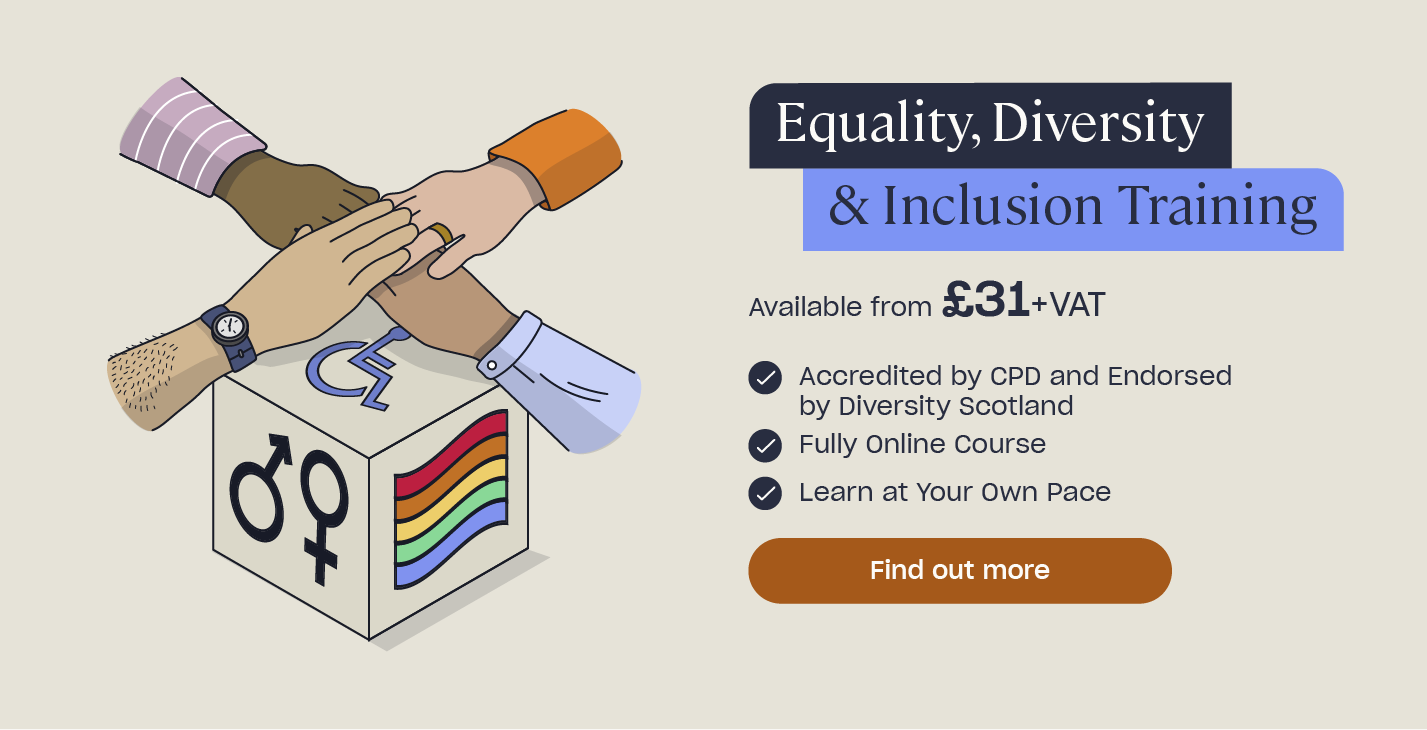Disabled Access Requirements for Restaurants
More than 13.3 million people in the UK reported having a disability in 2018 – that’s 21% of the population. As someone who works in the restaurant industry, can you afford to lose out on more than a fifth of potential customers simply because you haven’t made your restaurant accessible to those with disabilities? Not to mention missing out on some outstanding employees because you don’t feel disability confident.

This article will explain why making adjustments in your restaurant for disabled access is not only crucial for complying with equality law, but also for bringing reputational and financial benefits to your business. It will explain what the law requires and provide examples of suitable adjustments, so you can make your restaurant a more inclusive environment.
Why is Disabled Access in Restaurants Important?
Giving everyone the right to fair treatment is not just a moral duty, but also a legal one. The Equality Act 2010 and other statutory guidance documents explain that you need to make suitable adjustments to accommodate those with disabilities, whether they are an employee or member of the public.
Legal responsibilities aside, providing disabled access in your restaurant is also important because it can make you a beacon of accessibility – people with disabilities will feel much more comfortable going to your establishment. In a challenging industry like hospitality, having the support of your customers and local communities is essential to business longevity. In an industry where 40% of restaurants have no accessible toilet, your restaurant will stand out from the competition as an inclusive business.
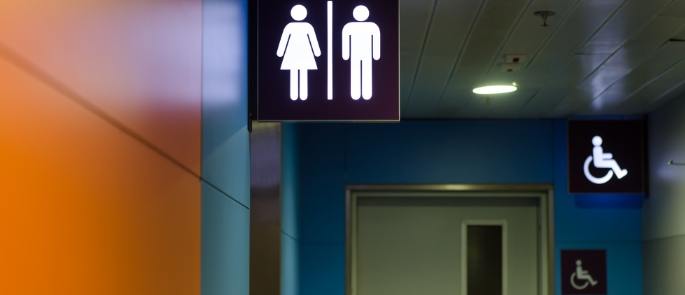
You’ll also inevitably increase your financial opportunities by providing disabled access. In fact, the disability awareness organisation We Are Purple reveals that restaurants, pubs, and clubs lose an estimated £163 million purple pounds per month. The purple pound refers to the spending power of those with disabilities and their families, and is currently estimated to be worth around £249 billion annually.
We Are Purple also states that 75% of disabled people and their families walk away from UK businesses because of poor accessibility or customer service. Disability access is clearly a determining factor when people with disabilities choose where to eat. If you want to make the most of this financial opportunity and build a positive reputation, you need to take access requirements seriously.
What are the Legal Requirements for Disabled Access in Restaurants?
As a business providing a service to the general public, there are certain laws in relation to accessibility that you need to comply with. More specifically, you should be aware of the UK’s anti-discrimination legislation, the Equality Act 2010, as well as the Approved Document M, which supports requirements of the Building Regulations 2010. The Approved Document states that everyone, including those with disabilities, should be able to enter, use, and exit a building.
The Equality Act 2010
Under the Equality Act, a lack of accessibility accommodations for both disabled employees and members of the public in your restaurant can be considered discrimination. The Act defines a person as disabled if they have a physical or mental impairment that has ‘substantial’ and ‘long term’ negative effects on their ability to engage in normal daily activities. For example, a ‘normal daily activity’, such as going out for lunch with friends, can be incredibly difficult for those with disabilities.
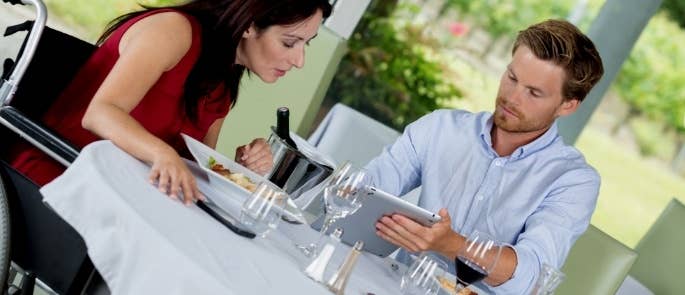
To prevent discrimination, the Equality Act therefore requires businesses to make reasonable adjustments that give everyone equal access to their services. This duty is ‘anticipatory’, which means your restaurant should think in advance about what is reasonably practicable, rather than wait for a complaint or request before you act. If a customer can prove that you haven’t made reasonable adjustments and this prevents them from accessing your services, they could make a discrimination claim against you.
What Does Reasonably Practicable Mean?
Reasonably practicable means that a business can consider whether taking an action is feasible given its resources and the complexity of what needs doing. In the case of disability access, this usually refers to whether the building has enough space and available facilities to install a suitably-sized and equipped disabled toilet.
You can find resources for size and equipment requirements of disabled toilets further into this article.
The Approved Document M
Part M of Schedule 1 to the Building Regulations 2010 covers access to and use of buildings other than dwellings. It states that businesses must make reasonable provision for people to gain access to and use the building and its facilities.
For example, page 48 provides detailed advice on the provision of toilet accommodation for buildings other than dwellings: “Wheelchair users should be able to approach, transfer to, and use the sanitary facilities provided within a building. This requires the provision of a wheelchair accessible unisex toilet.” Meanwhile, page 19 details ramped access requirements: “If site constraints necessitate an approach of 1:20 or steeper, an approach incorporating ramped access should be provided.”
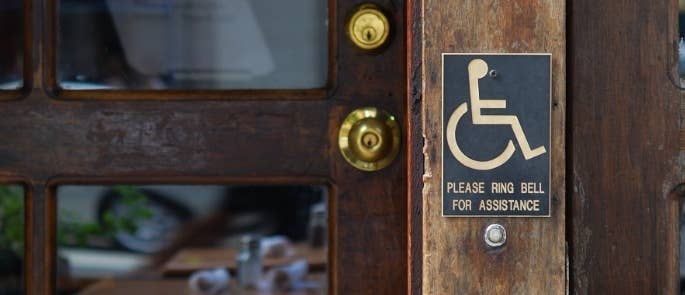
It’s important to note however that Regulation 9 of the Equality Act states that it may not be reasonable for a provider of services to remove or alter a physical feature if it:
- “(a) was provided in or in connection with a building for the purpose of assisting people to have access to the building or to use facilities provided in the building; and
- (b) satisfies the relevant design standard.”
This only applies when 10 years have not elapsed since the day on which construction or installation of the features was completed, which is known as the 10-Year Exemption. Therefore, if 10 years have passed since completion, the provisions of the time no longer apply and your business must make reasonable adjustments. New builds must comply with the most recent standards and provide facilities that accommodate those with disabilities.
Examples of Reasonable Adjustments for a Restaurant
There are different ways restaurants could comply with disabled access requirements. For example, Citizens Advice recommends three approaches for preventing discrimination in the provision of goods and services. These are: changing the way things are done, changing a physical feature of the premises, and/or providing extra help and services.
Changing the way things are done
Some restaurant dining areas may not enable those with physical disabilities to comfortably navigate. For example, if there isn’t enough room for them to move through the restaurant or if tables aren’t the right height for wheelchair users. You should therefore consider how to make your dining room as accessible as possible.
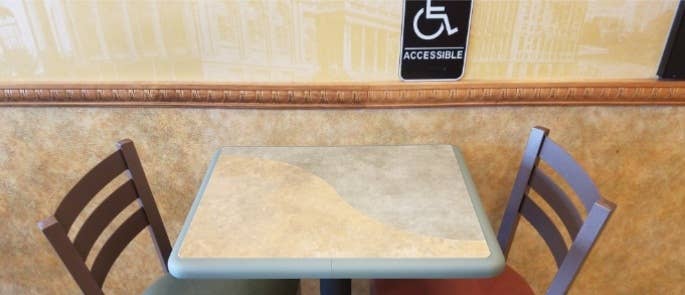
For example, look at whether there are tables near to the door, not up any steps, with plenty of space around them to benefit wheelchair users and others with physical impairments. You could also look at which seats have good lighting to benefit those with low sight, or are far from a speaker, which may benefit those with hearing difficulties.
When you have identified which tables are most accessible or have rearranged the room, you should implement a policy to reserve them for those with disabilities. Solving the needs of your customers preemptively will demonstrate that you have properly considered those with disabilities, which will make them feel like valued customers.
Changing physical features of the premises
When restaurants fail to consider disabled access, those who need it will have to struggle to navigate steps, small doorways, hard-to-grasp door handles, and tight spaces around tables and chairs – just to name a few issues. Look around your restaurant and ask yourself: what could you do to improve accessibility?
Follow the path of the customer as they enter your premises and think about what difficulties they may face accessing your premises. Make a list of all the things that might prevent a disabled person from entering, or moving about, the restaurant comfortably.
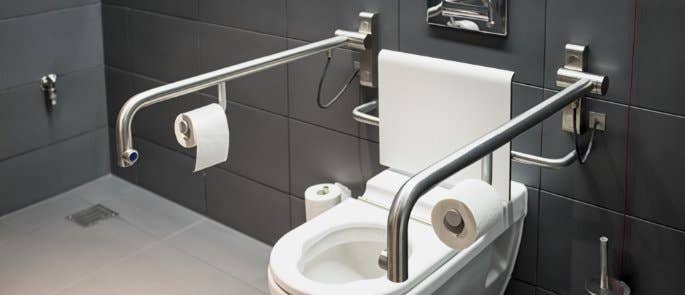
You may not be able to ‘fix’ all the things on your list, especially if it requires building work that is not reasonably practicable. Yet adding things like a ramp or fitting grab handles at different heights to assist mobility around the building, both inside and out, are all simple things you could do. Installing low level lighting and lit signs directing people to the things they need, such as the toilets, the till, or the exit points, will also positively impact accessibility in your restaurant.
Make sure you also look at your disabled toilet provisions and car park areas (if you have a car park). A lack of a toilet can be a huge barrier for those with disabilities and as potential customers they may choose to go elsewhere if they notice you don’t have one.
If you don’t already have a disabled toilet, think about whether the requirements detailed earlier in this article apply to you and if you should install one. Note that disabled toilets need to meet particular specifications – it can’t just be a non-disabled stall labelled as disabled. The Approved Document M also provides information about these specifications.
Providing extra help and services
Making changes to the way you do things and to physical aspects of the restaurant are all great approaches. However, you must make sure you provide extra help and services where practicable. For example, having staff to hand that can offer assistance and advice is a tremendous way to make customers feel comfortable in your restaurant.
Too often, disabled customers are put off by a lack of staff awareness. Feeling unwelcome will discourage any customer – disabled or not! Remember that, according to We Are Purple, 75% of disabled people and their families walk away from UK businesses because of poor accessibility or customer service.

From a staff point of view, they are often worried about causing offence and don’t know how to behave towards those with disabled requirements. You can help overcome this difficulty by providing staff with training. Make them aware of what accommodations your restaurant has, how they can communicate this to customers, and emphasise that disabled people have the same rights as anyone else. They should first and foremost see customers as people, not their disabilities.
Having a well-trained team will go a long way in making all your customers feel welcome and in making staff confident in delivering an inclusive service.
There is no doubt that restaurants need to do more to ensure they are accessible to everyone. It’s important to note that there’s not only a legal aspect to avoiding disability discrimination, but there’s also real monetary and reputational value in welcoming as many customers as possible, including those with disabilities.
There is clearly a commercial aspect, but there is also a human aspect, and a social responsibility to give fair treatment to disabled people as customers and as staff.
What to Read Next:
- Online Equality and Diversity Training Course
- Disability Awareness for Employers Training
- How to Help Others Promote Diversity, Equality and Inclusions
- Disability Awareness Quiz
- Daily Opening and Closing Checklists for Restaurants


